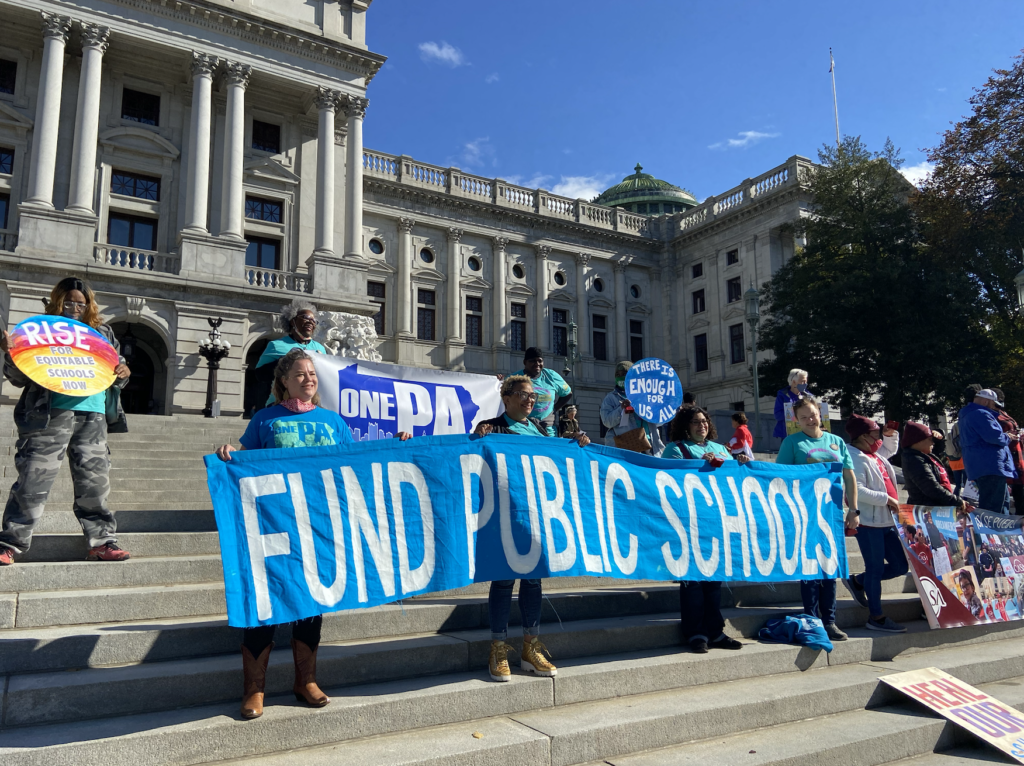The Next Step in School Funding: A Rural-Urban Coalition to Achieve Educational Equity
By ERIKA KITZMILLER

Students, families, and education advocates join Children First and Education Voters of Pennsylvania to host a rally on the Capitol steps to “ring the bells of justice,” and call for equitable funding for Pennsylvania public schools. The rally, which took place Friday, Nov. 12, 2021, occurred on the first day of the landmark trial that could change how Pennsylvania funds its 500 school districts. (Capital-Star photo by Marley Parish)
Last month, in a 786-page decision, Pennsylvania’s Commonwealth Court issued a landmark ruling that declared the state’s school funding system unconstitutional. The decision, which rested on months of witness testimony, marked the first time that a state court asserted that Pennsylvania’s school funding formula violated its constitutional obligation to support a “thorough and efficient” public school system.
No one should doubt the significance of the court’s decision. The ruling has the potential to alter education across the state, allocating millions of dollars to rural and urban school districts that for decades have been forced to fund their schools on the state’s inadequate and inequitable funds.
While the court ruling is a great victory for public education, it’s still a tenuous one. One can look at the history of the state’s largest school district to see why.
For over a century, state officials have refused to allocate funding to guarantee that Pennsylvania’s children have access to a “thorough and efficient” public school system. In 1916, the Philadelphia board of education announced that it lacked the funds to meet its operating expenses. The board appealed to the state to increase school funding. The state refused.
Rather than pressure state officials to act, for more than a century, Philadelphia educators turned to philanthropy, from wealthy residents, cultural institutions, and local foundations, to subsidize inadequate state educational funding.
The reliance on philanthropy to fund the city’s public schools masked the school district’s long history of fiscal instability. It also exacerbated educational inequities and created doubly advantaged public schools—schools that serve more wealthy and more white students and that can subsidize inadequate government support with substantial private funds.
For decades, inadequate state aid has forced Philadelphia school officials to cobble together school budgets that hardly meet the needs of the teachers and children in Philadelphia’s public schools.
Educational equity and justice will require more than a historical court ruling. It will require legislative action—something that has eluded Pennsylvania educators for over a century.
As history has shown us, Pennsylvania is a politically complicated and geographically diverse state with urban Democrats strongholds and rural communities dominated by Republican politics.
But there is a possible path forward embedded in the case itself.
This historic case brought these constituencies together to show that inequitable school funding significantly impacts the state’s urban school districts and dozens of communities in its rural hinterlands.
Securing a political solution to vindicate these newly articulated educational rights won’t be easy, but it is possible if Pennsylvanians find ways to bridge these political divides and pressure legislators to act so that all children—those in its urban centers and its rural outposts—finally have access to a “thorough and efficient” system of public schools.
This article has been republished from the Pennsylvania Capital-Star under a CC BY-NC-ND 4.0 license.
